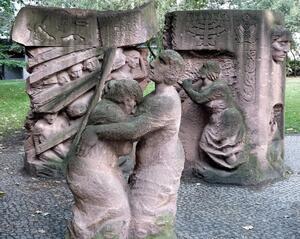The Women of Rosenstrasse
After moving from Tel Aviv to Berlin about five years ago, I started noticing that the sheer number of commemorative objects scattered around the city is quite astounding. Berlin has seen more radical changes in the last 150 years then most cities have in the last 1,000. From the Prussians to the German Kaiser, from the Weimar republic to Nazi times and subsequently division and reunification, it is a city of many identities.
As my interest in the history of Berlin started to grow, I slowly started to piece its story together someone once said that Berlin is “a city that's always in the process of becoming and never being.” So I started researching, first in order to soothe my curiosity and later for the guests who I was ushering around the city as a tour guide.
One of the most surprising stories caught me in what seemed to be a charmless back street behind a Soviet-style hotel, not far away from Alexander Platz. As I was passing by, I noticed a strange looking red stone sculpture of women and men and some Jewish symbols on a small grassy strip. When I started researching further in to the symbolic meaning behind the sculpture, what I found was revelatory.
In the winter of 1943, the head of the regional branch of the Nazi party in Berlin (and minister of propaganda), Josef Goebbels, decided to grant his Führer a present in the form of “a Jew-free Berlin.” He does that by collecting all the remaining Berliner Jews from the factories in which they were employed under forced labor conditions and transferring them to internment camps from which they would later be sent to the death camps in the east. This eventually came to be known as the "Factory campaign.”
The first transports of Jews from Berlin to the east started in late 1941, but because the Jews of Berlin proved to be such a crucial skilled and productive work force, the Nazis allowed some of them to stay in the city. Especially privileged were the ones who were working in factories that supplied goods which supported the German war effort.
There were three types of Jews that were still living in Berlin in 1943: Jews that were working in the aforementioned factories, Jews that were in hiding (about 7,000 in 1943) and Jews that were married to non-Jewish partners. The last group was relatively safe from deportation since being married to an “Aryan” allowed them to keep their German citizenship. The rest of Germany’s Jews lost their citizenship in 1935 under the Nuremberg laws.
On the 27th of February 1943, S.S., Gestapo, and policemen waited for the unsuspecting workers in the factories and loaded them on to trucks with haste. Some didn’t even have time to grab their winter jackets for the ride. The Jews in mixed marriages—both men and women—found themselves transported to the old familiar Jewish welfare office in the Rosenstrasse, right in the middle of Berlin. Around 2,000 people were imprisoned in this old office building where the conference rooms were converted into makeshift cells with mattresses on the floor.
In the following days something odd began to occur in front of the Rosenstrasse internment camp: a large crowed of “Aryan” women stood outside the building shouting “Give us our men back!” This form of protest—any form, for that matter—was unheard of under the Third Reich and the reaction to it came swiftly: a unit of combat soldiers was sent to point their guns at the women. The women refused to leave the premises and the soldiers were called back to their base without a single shot being fired. The protest went on for about a week, and it was said that up to 6,000 women took part in it.
Goebbels’s diary from the 6th of March 1943 refers to “unpleasant scenes in the Rosenstrasse.” Faced with the threat of a growing anti-Nazi protest in the middle of Berlin (during a very sensitive time after the German defeat in Stalingrad and the daily bombing of the city) it was decided to send the imprisoned Jewish spouses home. None of the women were arrested, a somewhat surprising end to this story.
Some historians claim that the release of the Rosenstrasse Jews had nothing to do with the protest because the Nazis had always intended to separate the Jews in mixed marriages from the other Jews as they they had no intention of deporting them.
Either way, this woman-led protest is a very thought provoking event that teaches us that protest under the Nazi regime was indeed possible. This is a claim that has been very often refuted.
For more about the Rosenstrasse story, I recommend watching the 2003 movie Rossenstrasse. The film might have a somewhat romantic angle on the subject, but it’s definitely a good source for learning more about this wartime anomaly.
And for those of you that still don’t have plans for the coming summer, I recommend visiting Berlin and experiencing this exciting city with its colorful present and dark past.








Thank you. I was looking for pictures of this protest, real pictures from an archive for a lesson lan but could not find any. It's nice that yoy add this piece of information that many are not aware of as it tells the sad story, ib contrast to what eople thought in the beginning, there was so much that could have been done. This protest symbolizes the missed opportunities - and there were plenty
Thank you for bringing my attention to this, I had never heard of it, and it points to an astonishing act of bravery. As you say, it shows that protest was possible.